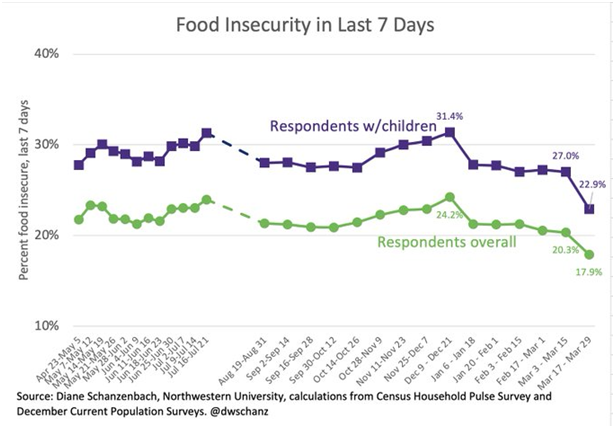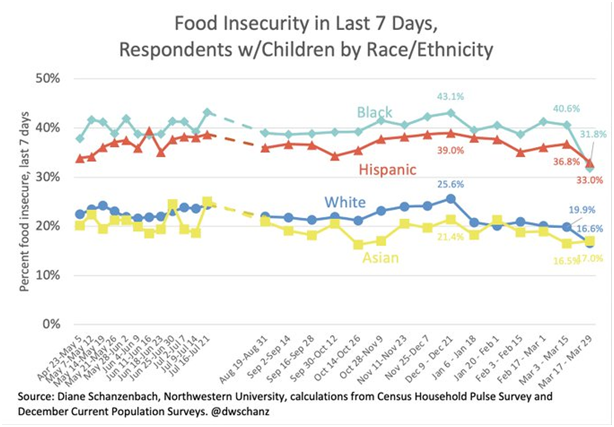The struggle to put food on the table
As many people know, millions of our neighbors across the United States are struggling to put food on the table. Only one short year ago, news outlets stunned the recently quarantined U.S. public with images of hours-long lines of cars and people desperately in need of food. Stories recounted families and individuals turned away because no food remained after thousands of pounds had already been distributed. Together, the underprepared food system and inadequate anti-poverty policies failed to feed everyone at the time when it was needed the most.
It’s an unfortunate reality that millions of people—older adults, children, young workers, families—are surviving day-to-day wondering where their next meal will come from. In fact, the Census Bureau’s most recent data from March 29, 2021 revealed almost 18 percent of all people living in the United States experienced food insecurity in the last seven days. This data marks the lowest levels of food insecurity since the pandemic began according to Dr. Diane Schanzenbach, economist at Northwestern University, who has been analyzing this data since April 2020. However, these levels of food insecurity remain highly elevated, and one hungry person is one person too many.

Children and older adults are suffering disproportionately from the combined impacts of pandemic. In New York City for example, 1 in 5 older adults are currently experiencing food insecurity. Insights published in March by Feeding America projects that 13 million children — 1 in 6 — will experience food insecurity in 2021. In the last seven days, 22.9 percent of families with children experienced food insecurity according to analysis by Dr. Schanzenbach. As children begin the gradual return to school with backpacks filled with hand sanitizer, many will arrive without food in their tummies or lunch boxes.
The uneven burden of hunger being placed on children and older adults is even more pronounced for Black, Indigenous, and People of Color (BIPOC). Racial inequity is a recognized root cause of hunger, leading to the disproportionate number of BIPOC individuals experiencing hunger especially in this moment. Recent analysis shows that over 20 percent of Black, Latinx, and Multi-racial or Other-identifying communities are experiencing food insecurity nationwide. Asian communities are experiencing food insecurity at 14 percent—lower than other racial and ethnic groups, but this figure masks very different experiences of hardship within different Asian-American communities and remains higher than food insecurity for white communities at approximately 13 percent. BIPOC children and older adults face the double burden of ageism and racism, causing even greater disparities of food insecurity for these populations.

Additionally, other forms of oppression have converged with the economic downturn of the pandemic to highlight critical food needs amongst people with disabilities and LGBTQ+ people. A May 2020 study shows that 1 in 5 adults with disabilities in New Hampshire experienced food insecurity. Analysis of June 2020 data indicates that 25 percent LGBTQ+ individuals and families reported receiving Supplemental Nutrition Assistance Program (SNAP) benefits during the month; in comparison, only 13 percent of the general population used SNAP for the same month. Unfortunately, due to data limitations for both populations, the exact extent of rising food insecurity has been difficult to determine empirically. Nonetheless, available analysis affirms anecdotal information regarding food insecurity for these populations.
The Great Recession demonstrated that food insecurity will lag behind economic recovery. With the current experiences of unemployment, we know food insecurity will not go away soon. Even prior to the pandemic, food insecurity was at abominable levels. The struggle to put food on the table and keep it there will not end soon.
Federal policies seek to address this struggle by increasing support for nutrition programs and providing much needed support to community-based organizations feeding people in their communities. The United States Department of Agriculture (USDA) has supplemented nutrition programs for individuals and families under President Biden’s guidance and the reception of additional funds through the American Rescue Plan (ARP).
- Through the advocacy efforts by RESULTS volunteers and others, Congress expanded SNAP benefits by 15 percent in the December 2020 bipartisan COVID relief package and again in the ARP.
- USDA has increased Pandemic EBT (P-EBT) benefits, a program providing families with nutritional assistance due to loss of reduced or free school meals from school closures, and issued new federal guidance to allow states to fully leverage already available student data.
- In addition to increasing benefits, the Biden administration has extended the P-EBT program into the summer months, allowing families to access crucial food assistance throughout the summer.
- Moreover, USDA has expanded the Child and Adult Care Food Program (CACFP) to provide reimbursement to CACFP facilities for meals provided to unhoused young adults (18-25 years old).
- The ARP has also invested approximately $900 million in the Special Supplemental Nutrition Program for Women, Infants, and Children (WIC) and has increased access to fresh fruits and vegetables for WIC participants.
- Prioritizing the food needs of older adults, USDA has provided an additional $37 million to the Commodity Supplement Food Program (CSFP)–as well as expanded CSFP to operate with Wichita and Affiliated Tribes.
- Similarly, in their effort to support schools planning their return to in-person teaching, USDA has extended key waivers allowing non-congregate meals with multiple meal options at flexible hours.
- In addition to these advances in nutrition policy, the Biden administration has also increased support for nutrition programs in U.S. territories such as Puerto Rico, American Samoa, and the Commonwealth of the Northern Mariana Islands.
For more on pandemic-era federal nutrition policies, see Jessi Russell’s overview on the RESULTS blog from last summer.
With increasing availability of vaccines throughout the United States, there is much discussion about having finally turned the tide of this pandemic. However, the Great Recession taught us that economic recovery—and the food security that it brings—will require at least several years to return to pre-pandemic levels. While it may feel like we are “saying goodbye” to the pandemic, we cannot forget the harsh realities that it has brought for many families, most especially Black, Indigenous, and People of Color. In the months and years to come, we must prioritize policies that ensure access to food for communities experiencing hunger. By standing together, we can demand the end to the injustices that create poverty and hunger.